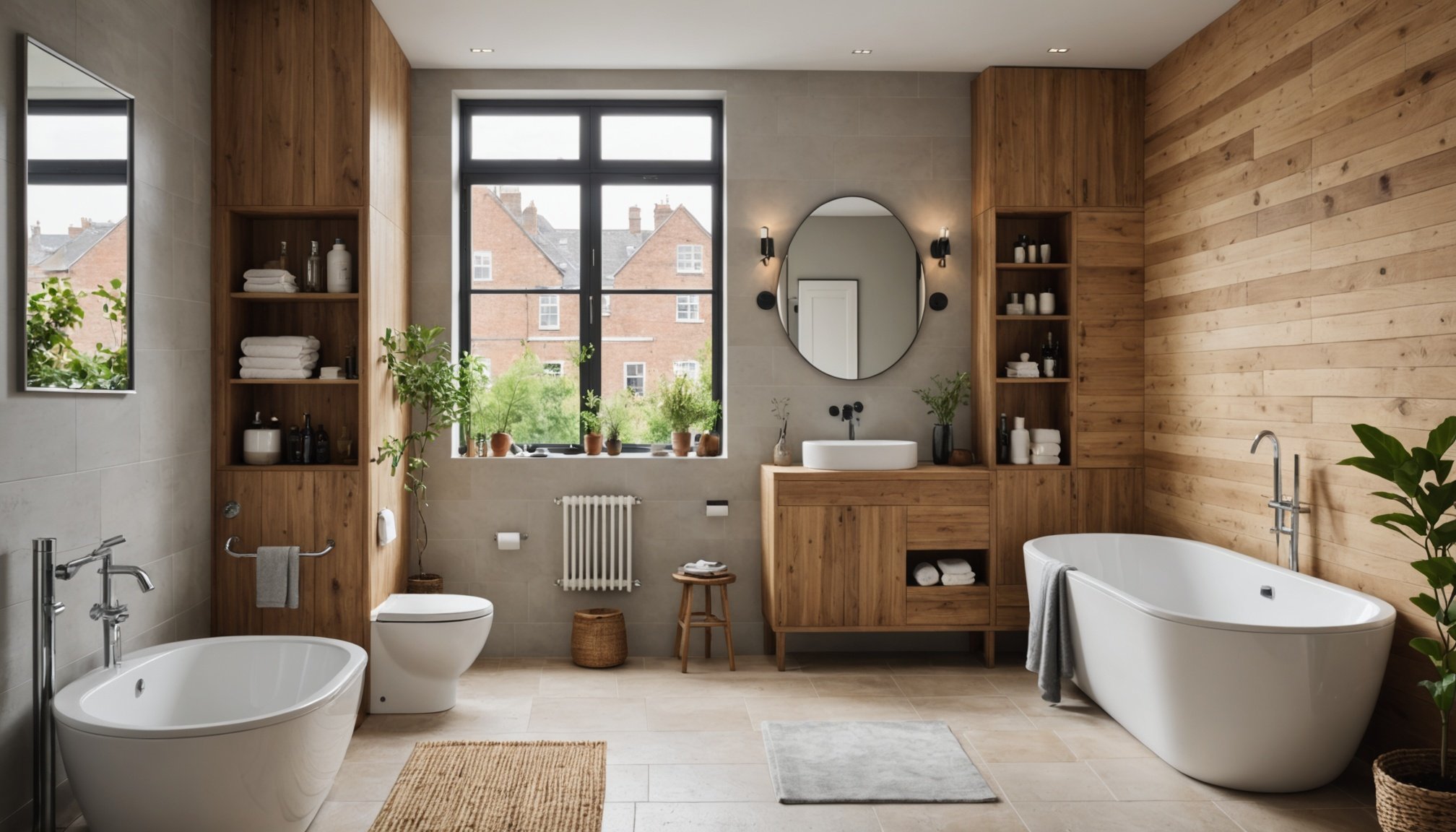Understanding Sustainable Bathroom Design
Embarking on an eco-friendly renovation can seem challenging, particularly with the multitude of choices available, but understanding sustainable bathroom design principles makes it more manageable. At the heart of this is the commitment to reduce environmental impact using eco-friendly materials, such as reclaimed wood, recycled glass tiles, and low-VOC paint.
A pivotal element of this design ethos revolves around staying informed. With the growing interest in sustainability, UK bathroom trends showcase innovative designs that integrate both functionality and environmental consciousness, making them both trendy and responsible. This means creating spaces that not only cater to modern aesthetics but also prioritize ecological benefits.
Also to discover : Essential Zoning Factors to Consider for Extending Your Detached Home in the UK
The trend of sustainable aesthetics marries eco-friendly renovations with cutting-edge design. Current styles emphasize simplicity, minimalism, and integrating nature into the living space, reflecting the philosophy that beauty needn’t compromise the planet. By embracing sustainable materials and methods, homeowners contribute to the broader goal of conservation while achieving a sleek and contemporary look.
Opting for eco-friendly materials is not only a win for the environment but also offers long-term financial benefits through reduced utility costs. By aligning with sustainable bathroom design, one can maintain both style and conscience.
In parallel : Creative Solutions for Maximizing Space in a UK Three-Bedroom House for Large Families Without Extensions
Choosing Eco-Friendly Materials
When stepping into the world of sustainable bathroom design, picking the right eco-friendly materials is paramount. A favoured option for floors is bamboo, known for its rapid regrowth and durability. Cork and linoleum also shine for their resilience and renewability, adding warmth to any bathroom.
In the realm of bath fixtures, low-flow faucets and dual-flush toilets lead the charge in water conservation. These upgrades are not only effective in conserving water but are also cost-efficient, meaning savings on water bills over time. The incorporation of aerators in taps further optimises water usage without sacrificing performance.
Opting for recycled or upcycled materials is another savvy choice. Recycled glass tiles or upcycled metal hardware offer unique style while lowering environmental burdens. Such choices not only satisfy both form and function but also enhance the overall aesthetic with rich textures and colours.
Maintenance of these eco-friendly materials is generally straightforward. Regular cleaning without harsh chemicals preserves their integrity, making them viable for long-term use. Engaging in eco-friendly renovations allows homeowners to meld personal style with eco-conscious choices, ultimately fostering a sense of pride and responsibility towards the environment.
Energy and Water Efficiency
Achieving a balance between comfort and eco-friendly technologies is possible with thoughtful choices in energy and water efficiency. Low-flow showers and toilets are fundamental in this respect, significantly contributing to water conservation efforts by reducing usage without compromising functionality. They offer substantial savings, lowering household water bills over time.
Innovative technologies, such as smart meters, track water usage in real-time, allowing users to identify patterns and make informed adjustments. These systems enhance energy efficiency by providing insights into consumption.
Energy-efficient lighting, like LED bulbs, and modern heating solutions, such as tankless water heaters, further reduce energy demands. These choices can cut utility costs while offering substantial environmental benefits. Integrating these features during the renovation phase ensures long-lasting benefits.
For homeowners keen on eco-friendly renovations, embracing these efficient technologies is a strategic advantage. It’s a pathway to cutting waste and optimising resources while improving the overall bathroom experience. Taking the first step towards energy and water efficiency can transform not only your bathroom but also contribute positively to environmental sustainability.
Styling Your Eco-Friendly Bathroom
Creating an eco-friendly bathroom that isn’t just functional but also fashionable is achievable with the right approach. Bathroom styling tips focusing on sustainable, yet stylish decor can add a unique charm. Maintaining an eco-chic appeal starts with choosing a suitable color scheme. Opt for muted earth tones or vibrant planet-inspired palettes to enhance the sustainability of your bathroom.
When aiming for eco-chic decor, incorporating plants is a delightful way to add a touch of nature. Plants not only purify the air but also introduce a refreshing aesthetic. Position them strategically for an optimized balance of style and function. Consider easy-care species that thrive in humid environments, like ferns and pothos.
Adding sustainable accessories ensures the bathroom remains on-trend while being environmentally responsible. Swap traditional items for those made from recycled or natural materials. Whether it’s a reclaimed wood mirror or bamboo trays, these choices underscore your commitment to sustainability.
Harmonizing style with sustainability often leads to an organized, visually appealing space. This balance encourages conscious living, promoting both a soothing environment and a responsible lifestyle. Embrace creativity while reducing your ecological footprint for a truly sustainable bathroom design.
Practical Steps for Transformation
Renovating a bathroom with eco-friendly renovations involves a thoughtfully crafted action plan. Start by identifying key areas for improvement in your current space. This ensures a focused approach towards a sustainable transformation, aligning efforts with your vision of a sustainable bathroom design.
Budgeting is essential. Evaluate the potential costs of sustainable products like eco-friendly fixtures and materials. Allocate funds wisely to balance quality and affordability. Consider long-term savings from reduced utility bills when assessing the costs of implementing energy efficiency measures.
For those inclined towards DIY eco-bathroom projects, there are numerous strategies to cut costs while crafting a functional and stylish bathroom. Utilize tutorials and resources to gain skills, making simple upgrades like installing low-flow faucets and toilets more accessible.
Incorporate UK bathroom trends by exploring current styles and sustainable techniques. These insights offer inspiration for integrating innovations while maintaining practical goals. Aim to achieve a harmonious blend of aesthetics and environmental responsibility.
Ultimately, the journey to a transformed bathroom encourages creativity and mindful decision-making. By embracing an eco-friendly transformation process, you foster a space that’s not only beautiful but contributes positively to the planet.
Real-Life Case Studies
Exploring successful bathroom transformations illuminates the possible impacts of eco-friendly renovations. Eco-friendly success stories offer tangible insights that inspire confidence and creativity in sustainable design projects.
Highlighting Successful Projects
- One notable project transformed a water-intensive bathroom into a sanctuary of water conservation using low-flow fixtures. The homeowner reported a 40% drop in water bills post-renovation.
- Another case focused on using sustainable products like bamboo flooring and recycled glass tiles, balancing aesthetics with environmental responsibility.
These stories exemplify how small yet focused changes can have significant results, demonstrating the adaptable nature of sustainable design principles.
Testimonials from Homeowners
Homeowners who embarked on these journeys share their perspectives: “Transitioning to an eco-friendly bathroom was daunting, but the rewards, like reduced utility bills, made it worthwhile,” said one participant. Another noted the sense of pride from aligning personal values with their living space.
Lessons Learned from Each Transformation
Key lessons from these before and after bathroom makeovers include the importance of planning, selecting the right materials, and understanding potential challenges. They highlight that an informed, deliberate approach leads to successful eco-friendly transformations, motivating others to pursue sustainable living spaces.
Resources for Eco-Friendly Choices
When embarking on an eco-friendly renovation, it’s essential to have access to reliable resources. Identifying providers of sustainable products is crucial for executing an environmentally conscious bathroom design. Many eco-conscious brands now specialize in materials like reclaimed wood and recycled tiles, offering products that promote environmental responsibility.
For those seeking further inspiration, numerous websites and blogs delve into UK bathroom trends and sustainable design. These platforms provide in-depth articles, showcasing the potential of eco-friendly renovations and offering valuable guidance on trends and styles. They also facilitate community interaction, allowing readers to share tips and experiences for a more collaborative approach to sustainability.
Local community resources and workshops often provide hands-on opportunities to learn about sustainable building practices. These initiatives support homeowners by offering practical advice and demonstrations, making it easier to implement sustainable bathroom design in everyday life.
The combination of accessible information, community support, and trusted brands ensures that anyone undertaking an eco-friendly bathroom renovation is well-equipped to make informed and impactful choices. This network of resources empowers homeowners to contribute effectively to the broader environmental movement.











